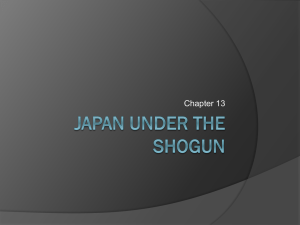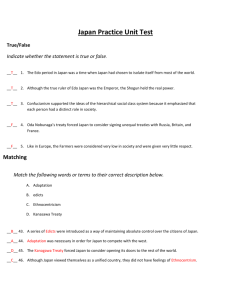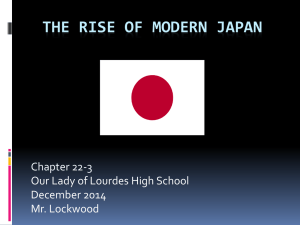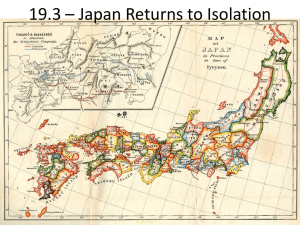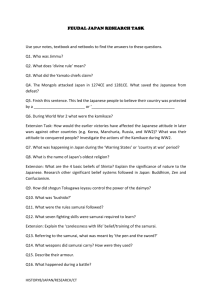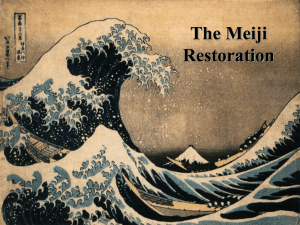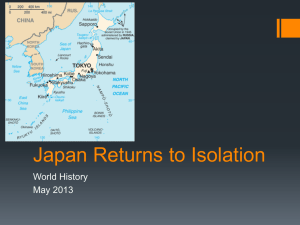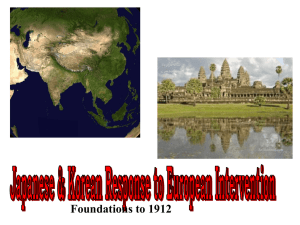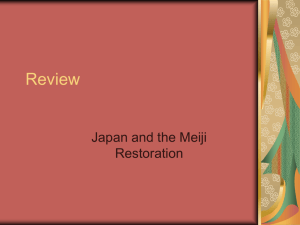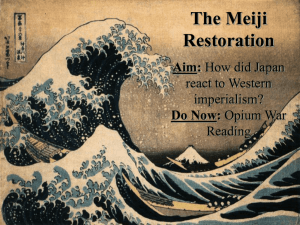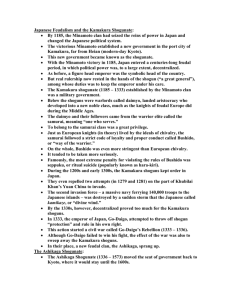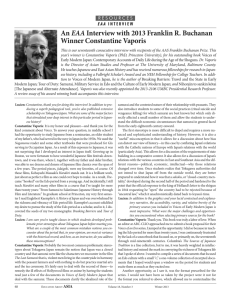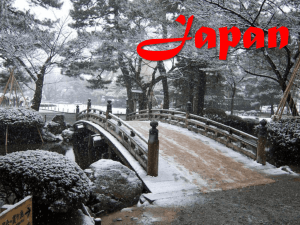Study Guide
advertisement
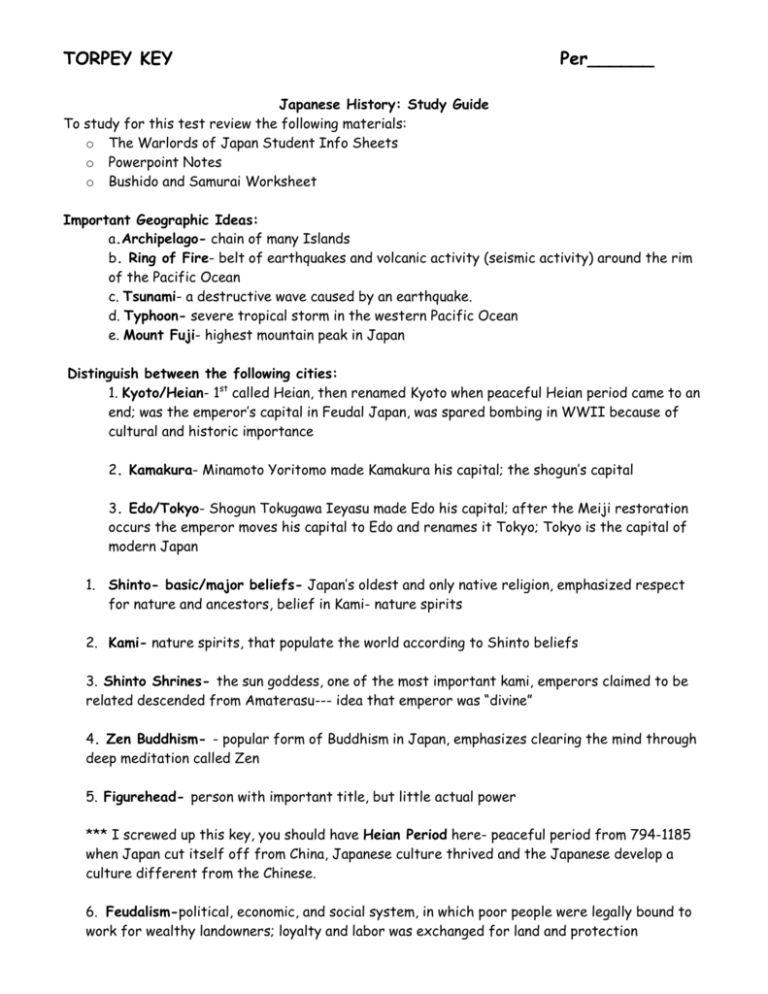
TORPEY KEY Per______ Japanese History: Study Guide To study for this test review the following materials: o The Warlords of Japan Student Info Sheets o Powerpoint Notes o Bushido and Samurai Worksheet Important Geographic Ideas: a.Archipelago- chain of many Islands b. Ring of Fire- belt of earthquakes and volcanic activity (seismic activity) around the rim of the Pacific Ocean c. Tsunami- a destructive wave caused by an earthquake. d. Typhoon- severe tropical storm in the western Pacific Ocean e. Mount Fuji- highest mountain peak in Japan Distinguish between the following cities: 1. Kyoto/Heian- 1st called Heian, then renamed Kyoto when peaceful Heian period came to an end; was the emperor’s capital in Feudal Japan, was spared bombing in WWII because of cultural and historic importance 2. Kamakura- Minamoto Yoritomo made Kamakura his capital; the shogun’s capital 3. Edo/Tokyo- Shogun Tokugawa Ieyasu made Edo his capital; after the Meiji restoration occurs the emperor moves his capital to Edo and renames it Tokyo; Tokyo is the capital of modern Japan 1. Shinto- basic/major beliefs- Japan’s oldest and only native religion, emphasized respect for nature and ancestors, belief in Kami- nature spirits 2. Kami- nature spirits, that populate the world according to Shinto beliefs 3. Shinto Shrines- the sun goddess, one of the most important kami, emperors claimed to be related descended from Amaterasu--- idea that emperor was “divine” 4. Zen Buddhism- - popular form of Buddhism in Japan, emphasizes clearing the mind through deep meditation called Zen 5. Figurehead- person with important title, but little actual power *** I screwed up this key, you should have Heian Period here- peaceful period from 794-1185 when Japan cut itself off from China, Japanese culture thrived and the Japanese develop a culture different from the Chinese. 6. Feudalism-political, economic, and social system, in which poor people were legally bound to work for wealthy landowners; loyalty and labor was exchanged for land and protection The Power Structure: identify jobs, roles, quality of life, any other important details. a. Merchants- sold goods produced by others, could grow rich, but were not highly respected because they lived off the work of others, were seen as parasites, didn’t make anything- only sold what others made b. Artisans- craftspeople, made goods and tools for the other classes, artisans that made fine swords were greatly respected c. Peasants- poor farmers and laborers, produced food for the other classes, many farmed rice or fished, paid taxes in the form of rice and work, poor but respected because they made food for all the other classes; still respected because they produced food d. Ronin- samurai without masters, soldiers for hire, can be seen as being outside the class system, some worked as ninja e. Samurai- professional, highly skilled warriors, were extremely loyal to the daimyo (would die for him), collected taxes and fought for daimyo f. Daimyo- nobles/warlords/generals of feudal Japan, high-ranking members of warrior class, loyal to Shogun, owned land and ran estates, collected taxes, ran estates, had large armies of samurai g. Shogun- - supreme military commander, highest member of warrior class, truly ran the country, had the real power h. Emperor- most highly respected, but didn’t truly run the country, claimed to be descendant from the sun goddess Amaterasu 7. Bushido- strict honor code followed by Japanese samurai emphasized bravery, loyalty, and death before dishonor 8. Seppuku- ritual suicide through disembowelment, samurai were expected to commit seppuku rather than face defeat, surrender, or upon committing a dishonorable action 9. Minamoto Yoritomo- first shogun of Japan made his capital in Kamakura, founds the Kamakura Shogunate 10. Kamakura Shogunate- (shogunate means a government run by a shogun) term to refer to the government of the Minamoto when they ruled from the city of Kamakura 11. Kublai Khan and attempted invasion of Japan- Mongol ruler who tried, and failed to take over Japan two times, both times his invasions were thwarted by bad weather, the 2nd time many of his ships were destroyed by a typhoon. The Japanese called this typhoon that stopped the 2nd invasion kamikaze meaning “Divine Winds” will also be the name for Japanese fighter pilots in WWII. 12. Arrival of Europeans- Who? When? What did they bring? Portuguese sailors arrive in 1543 during Warring States Period- when Japan was chaotic, war torn, while different daimyo fought for power. They brought guns, Christianity (Catholics), and wanted to open up Japan for trade. This was a lot of change to introduce to a society in the middle of an already chaotic time period *. Oda Nabunaga- he wasn’t on your study guide, but for LA honors kids- he was the 1st of the three unifiers, conquered a great deal of Japanese territory during Warring States period, remembered as both one of the greatest and most brutal rulers of Japan 13. Toyotomi Hideyoshi- from peasant background, but became very powerful general and eventually rose to become the most powerful warlord, was never officially named shogun because he was born top peasant class (but he really was top-dog), ENFORCED FEUDALSIM to ensure power, sword hunts- peasants can’t have weapons, samurai cannot farm, sent forces to invade Korea- they return to Japan when he dies 14. Tokugawa Ieyasu- ends long period of war and unifies Japan, bans Christianity, expels foreigners, isolates Japan from most of the outside world and imposes strictly imposes class structure------ enforces FUEDAL ROLES, moves capital to Edo, forces daimyo to live there part of the time keeps their family in Edo when they are not there 15. The Tokugawa Shogunate or Edo Period- refers to the government of the Kamakura when they rule from the city of Edo- was a time of isolation and when feudal roles were strictly enforced, Tokugawa keep power until the emperor takes it back during Meiji restoration 16. Japanese Isolation- Due to its geography Japan was often isolated from the rest of the world, under the Tokugawa Shogunate Japanese expelled foreigners and purposefully “closed its doors to the world” 17. Arrival of the Americans- When? Who? How did it change Japan? 1853 Americans arrive under Commodore Matthew Perry (not actor from Friends), he returns a second time and Japanese sign treaty, start of Japan “opening up to the world,” eventually Japanese start trading and modernize Other questions to consider: 18. What was the preferred weapon of the samurai? Peasants swords 19. What marks the entrances to Shinto Shrines? torri gates 20. Name the Mongol ruler of China who tried to invade Japan two times: Kublai Khan 21. The United States defeated Japan in what major conflict in the modern era? WWII 22. What was the name of Japanese fighter pilots in WWII? Kamikaze 23. What does their name mean? Divine Winds 24. Name two food staples of the Japanese diet: rice & fish 25. How many main islands make up Japan? 4 Add this on: Meiji Restoration: starting when last shogun is removed from power (1867) refers to period of time (started by emperor Meiji) when emperor takes power back from military and bans samurai class




